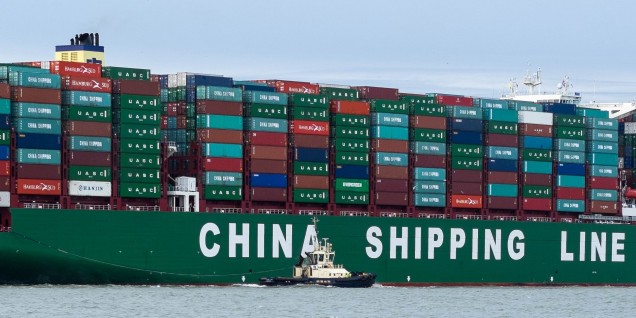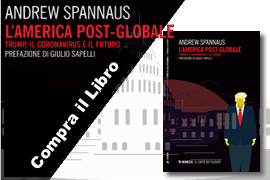– Remarks by Andrew Spannaus –
at the American Studies Center, Rome, October 7, 2019.
In the past few years I have been concentrating on the macroeconomic drivers of what I call the “revolt of the voters” across the Western world. This is the approach I want to start with in looking at the U.S.-China relationship.
The role of China has gotten a lot of attention from Donald Trump in particular, as one of the targets of anti-globalization rhetoric, and of an attempted shift in policy with the stated goal of stopping the process of massive outsourcing, bringing manufacturing jobs back to the United States.
The general argument on this point is quite simple: the free-trade model of seeking low wages and lack of regulation has seriously damaged Western economies, hurting the middle class, and contributing significantly to discontent and fear, affecting the identity and sense of belonging of certain segments of society. So it goes beyond just the loss of well-paying, stable jobs, to dovetail with the reaction to immigration, a cultural reaction that is quite evident and often harshly criticized.
The counterargument on jobs, has been that technological innovation is the main driver of job losses, and that in any event the numbers say the U.S. economy is doing well.
Recent research has cleared the air a bit on this front – from David Autor of MIT, and from the Economic Policy Institute, for example – indicating that yes, the United States lost millions of jobs to China, and the process has also driven down wages in the country. By the way, this has disproportionately affected certain areas of the country, which were essential for the election of Donald Trump.
The accompanying political counterargument to this straightforward analysis of the anti-system outbreak, claims that it’s really only about identity in a strict sense, and that racism and reactionary attitudes are the key factor.
This also not too hard to refute, in my view, if we look at the numbers. But most importantly, it’s not one or the other; the issues are mixed together, as identity is a broad concept that includes people’s role in the economy, and a country’s role in the world.
I am somewhat suspicious of attempts to rule out the economic factor completely; it seems like an effort to defend a specific position, that of globalization and free trade, with the fear that a new political class may actually seek serious structural changes.
And regardless of what economics professors think, the population is certainly convinced such change is needed: from Trump to Elizabeth Warren and Bernie Sanders, a consensus has emerged – among voters, much less among elites – that the current system damages so-called “normal people”.
And despite establishment push-back against this view, if there’s one area where Donald Trump has the support of the majority of institutions in Washington, it’s on China, to the point that he is even being pressured to take a strong position by anti-China legislation in Congress.
Now, is this China’s fault? Has China been taking advantage of us?
Well, there are certainly many important issues the U.S. points to as unfair practices, from intellectual property to restrictions and protectionism in the Chinese economy.
However, it is a bit dishonest to suggest that the Chinese created this situation themselves, and that we were innocent bystanders. Outsourcing of production was driven by a corporate mindset and economic view in which low costs and lack of regulation were king. Profits soared, and the fact that some of the population was losing out, didn’t seem to matter much.
When I first came to Italy, in the second half of the 1990s, I would speak to various business associations and local political groups about international economic prospects and the geopolitical implications of the economic transformation of the 1990s.
There were two main issues: the risk of a catastrophic crash due to the explosion of financial derivatives that had made the speculative component of the system much larger – in nominal terms – than the real economy; and then I often presented a report written by a group in the U.S. on something called the “New Silk Road”. With some detail, I explained how China had recognized that it was time to begin large-scale public investment in infrastructure, a massive program to increase the efficiency of the economy and create modern connections with the West, bringing economic development along the new transport corridors.
The point was this: while China was beginning a huge program of infrastructure investment, in the West we were merrily sailing along with the illusion of the Wall Street economy; the idea that financial innovation is the driver for economic growth.
This approach was making a lot of money for the upper portion of the population, but leading to the loss of manufacturing, crumbling infrastructure, and the hollowing out of the middle class.
The rise of GDP was hiding the rapid post-industrial transformation of our economy.
And the challenge was as follows: if we continue down this road, we will lose real power, and China will grow. The smart thing would have been to return to policies based on public investment and the physical economy, and to attempt to engage China, work together on large infrastructure projects.
The actual response, from the few people who were paying attention back then, was that this was a threat to the West, we needed to counter the emerging alliance of the Strategic Triangle Russia-China-India, the name given by Yevgeny Primakov.
And the corollary was, we would just keep going with our domination of the international economy through finance and Western institutions, and try to isolate our enemies through strategic tactics.
Well, how did that work out?
Fast-forward to today, to the Trump Presidency.
We are now suffering the consequences of our past decisions. We indeed have lost economic, and political, power around the world; China has stepped in to fill the void in many cases: Africa and Latin America are two obvious examples.
The Belt and Road Initiative – the name given the project by Xi Jinping – is now seen as a threat by many in the West. Yes, numerous European countries seek investment from China. Trade is a reality, so they want to be a part of it, and try to become partners in a global project that they hope can open up great opportunities for their industries.
However, if the Silk Road means bringing products to the West that undercut local production, that’s not exactly a winning strategy.
The supporters of trade uber alles will tell us that trade goes both ways. We just need to do a better job of selling our products to the Chinese. This is certainly an important point; there’s a middle class of hundreds of millions of people. But I think the structure of the global supply chain today is quite problematic: based too much on exploiting low costs wherever we can find them, while sending semi-finished products half-way around the world. This has social, political, and also environmental consequences that we cannot ignore.
It is also quite telling that tariffs affecting the auto sector are able to drive a fair amount of the world economy towards recession. This shows an imbalance, a fragility, to be so dependent on trade, and not be able to drive economic growth internally.
The anti-globalization push suggests we need to change this, urging a return of the state, with aspects of protectionism. National sovereignty is not a bad word; we are moving towards a return to politics, rather than only markets, as a driver of economic policy. “Moving toward”, I say; we’re certainly not there yet. But again, the shift is widespread: while Trump pushes what his circle calls economic nationalism, Elizabeth Warren speaks of “economic patriotism”. It’s likely the shift will continue in the United States.
Trade War – Trade Deal
Let me address the immediate situation: the trade war, and some details of the economic relationship between the U.S. and China, before concluding.
Talks start again in a few days, and there is a desire to reach a deal relatively soon. Both sides recognize the effects being seen on the global economy.
There could be a limited deal in the short-term. The sides would freeze new tariffs. China would agree to more agricultural purchases – Trump needs this for internal purposes. Other points that could be addressed are the waiver for Huawei and currency manipulation.
It is likely we would not see one big deal, but that some large issues will be kicked down the road, and dealt with in a series of smaller deals.
There are some very important issues that are hard to deal with, seen as red lines by both sides: intellectual property, enforcement and penalties for trade violations, the role and openness of SOEs.
I don’t anticipate a resolution; these will fester, and of course it is possible China will succeed in waiting out Trump on some issues, given that he could be gone in a little over a year.
The question for me is if such a deal, or deals, represent a significant step towards structural change of the global supply chain. Not much, in my view, at least far from what is needed.
I want to use the example of the financial services sector, an area where the U.S. hopes to get into the game. China seems willing to allow limited U.S. firms access, as the Chinese are not very developed in the area. China has made some concessions: removing caps on investment in certain types of banks and insurance companies.
Let’s say China continues to open up on this front, makes some more agricultural purchases, and becomes more transparent.
Is that enough to change the U.S. economy, or the economies of Europe, to deal with their structural problems?
We still have a problem of the structure of the supply chain; a financial, speculative mentality. Improving financial services represents a focus on an area which continues to breed inequality.
Overall, there is a need to focus on reorganizing and encouraging production, improving working conditions and increasing wages. Trump’s deal with Mexico and Canada partially addresses that, but doesn’t go nearly far enough, and there are worries that it is unenforceable.
Digital (Industry 4.0) provides an opening on this front, as labor costs are no longer as important a factor. But we are mostly seeing production move from China to other, cheaper countries like Vietnam, not back to Ohio, at least not to a significant extent.
Another problem is the skills gap. Around the West manufacturing is growing in some areas – not as much as has been claimed, especially in the U.S. where there is now a “manufacturing recession” – but there is difficulty finding trained workers.
There is a discussion on how to ensure proper education, the right type of training. But either way, it costs money. Governments need to provide incentives so that companies can train workers for 1-2 years, and companies need to be able to invest as well, taking a long-term approach.
Trump’s tax cuts brought money back, but much went into stock buybacks. A decision to refocus on production is political; you can’t simply ask business leaders to be patriotic. You have to create the conditions; that’s the role of politics, the role of governments.
To do this, the key is to abandon the short-term view of shareholder value; that idea has political and social consequences, which are before our eyes every day in the West.
Such a change requires incentives, and public investment. The area where Trump has not at all done what he promised, is infrastructure. He promised to stop spending trillions on foreign wars, and spend it to rebuild the country – at least 1 trillion on infrastructure – but nothing has been done beyond ordinary admin.
There are real challenges, real issues between the U.S. and China.
You can’t have a full-scale Cold War, because we are so intertwined: 70% of shoes sold in the U.S. are from China. 90% of active pharmaceutical principles come from China. The Pentagon is worried this is a national security risk. On the other hand, the Chinese need the finished drugs made in the US. There’s also the issue of rare earth metals: China controls the market, and in May threatened to use them as a weapon in the trade war. So if there’s going to be some sort of de-coupling, it will be soft for now; anything large will take a long time.
Yet the Americans are aware that China seeks to be a great power.
China hopes the yuan will emerge as a global currency, competing with the dollar. China seeks hegemony in Artificial Intelligence, which has important implications for manufacturing, the shift to a high-technology economy; but also social and political implications.
Along with economic power comes military presence: we see this in the disputes in the South China Sea, and new military bases in other areas of the world. And China is investing heavily in advanced military equipment, such as hypersonic missiles, showcased a few days ago in the parade in Beijing.
This creates great risks. Everyone is familiar with the notion of the Thucydides trap – the fear that China will supplant the U.S. making a conflict inevitable.
My view is that the short-term issues can clearly be managed, but the larger question of the growth of China’s international projection, the defense of the role of the West, make the stakes much higher than just avoiding a recession due to the auto industry, or buying more soybeans.
We have created a global economy which has serious structural issues, with pervasive political implications.
We need to work on reorganizing that structure, with a focus on infrastructure, innovation, production and education, so that the West will not feel it is being overwhelmed by China, but rather we can compete in a healthy way, in a Westphalian world where we respect each other’s sovereignty, and use our values and principles as an asset.







October 22, 2019
Economia, English, Notizie, Politica